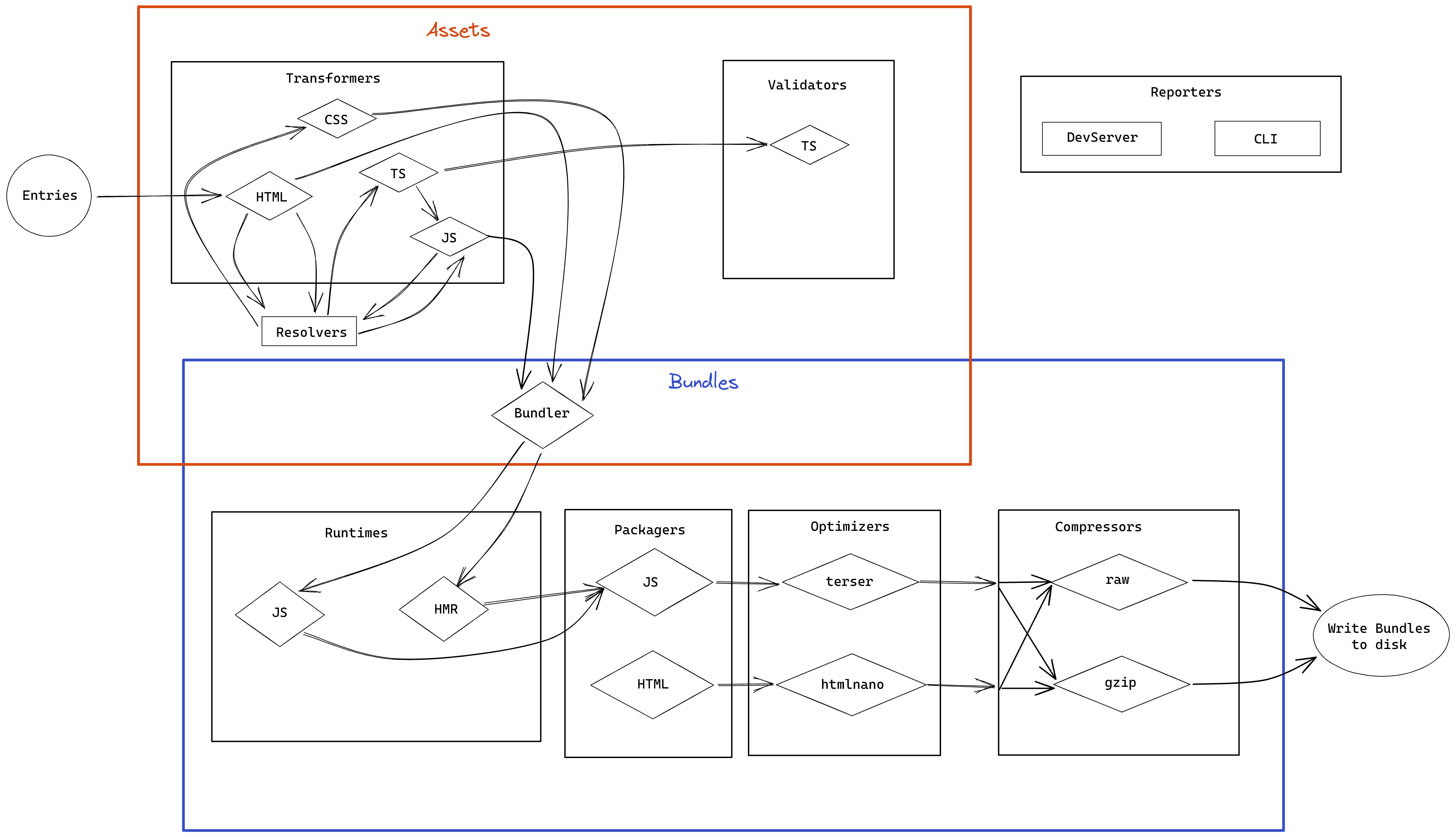Plugin System Overview
A high-level overview over the plugin system

Parcel Architecture
#Even if you aren't doing anything that complex, if you are going to use Parcel a lot it makes sense to take some time and understand how it works.
Entities
#- Asset: In the simplest case, an asset corresponds to a source file (e.g. a TypeScript file on disk). However, a transformer can not only modify (transform) an asset, but can also return more than one asset for a single input asset.
- Dependency: A dependency models an asset requesting some other asset (e.g. a
import "foo";declaration in JavaScript, or a<link rel="stylesheet">in HTML). They are explicitly added by a transformer (and sometimes called outgoing dependencies). Additionally Parcel also tracks which assets these dependencies point to and exposes this information as the incoming dependencies of an asset (thus listing the importers of some asset). - Bundle: A bundle is a grouping of assets that will be written into a single file for browsers to load. Async bundles are bundles created for lazy dependencies (e.g. for
import()calls), and shared bundles contain assets used by multiple other bundles and were separated for improved load performance.
Phases of Parcel
#At a high level Parcel runs through several phases:
- Resolving
- Transforming
- Bundling
- Naming
- Packaging
- Optimizing
- Compressing
The resolving and transforming phases work together in parallel to build a graph of all your assets.
The assets are grouped into bundles in the bundling phase. The output filename of each bundle is determined in the naming phase.
Then, the packaging, optimizing, and compressing phases work together to generate the final contents of every bundle, in parallel.
The packaging phase merges the assets in each bundle together into output files.
The optimizing phase transforms the contents of each bundle. When this is done, Parcel determines the content hashes of each bundle, which are applied to the final output filenames.
Finally, the compressing phase generates one or more encodings for each output file as they are being written to the file system.
Asset Graph
#During the resolving and transforming phases, Parcel discovers all the assets in your app or program. Every asset can have its own dependencies on other assets which Parcel will pull in.
The data structure that represents all of these assets and their dependencies on one another is called the "Asset Graph".
Bundle Graph
#Once Parcel has built the entire Asset Graph, it converts it into the Bundle Graph, which contains the Asset Graph and additionally describes which assets should be grouped together into bundles (and what the relationship between these bundles is).
Some assets are considered "entry" points into your app, and will stay as
separate bundles. For example, if your index.html file links to an
about.html file, they won't be merged together.
Complete List of Plugin Types
#- Transformer: Converts an asset (into another asset)
Example: convert Typescript to JavaScript (per file) - Resolver: Turns dependency requests into absolute paths (or exclude them)
Example: add your own syntax for imports, e.g.import "^/foo" - Bundler: Turns an asset graph into a bundle graph
Example: create a bundler that does vendoring (splitting app and node_modules code) - Namer: Generates a filename (or filepath) for a bundle
Example: place output bundles in a hierarchical file structure, omit hashes in bundle names - Runtime: Programmatically inserts (synthetic) assets into bundles"
Example: add analytics to every bundle - Packager: Turns a group of assets (bundle) into a bundle file"
Example: concatenate all input CSS files into a CSS bundle - Optimizer: Applies modifications to the finished bundle (similar to a transformer)
Example: run a minifier or convert into a data-url for inline usage - Compressor: Compresses or encodes bundles in one or more ways
Example: compress a bundle with Gzip - Validator: Analyzes assets and emit warnings and errors
Example: do type-checking (TypeScript, Flow) - Config: A reuseable '.parcelrc' package
Example: provide a tailor-made parcel config for your boilerplate - Reporter: Listens to events of the build
Example: generate a bundle report, run a dev server